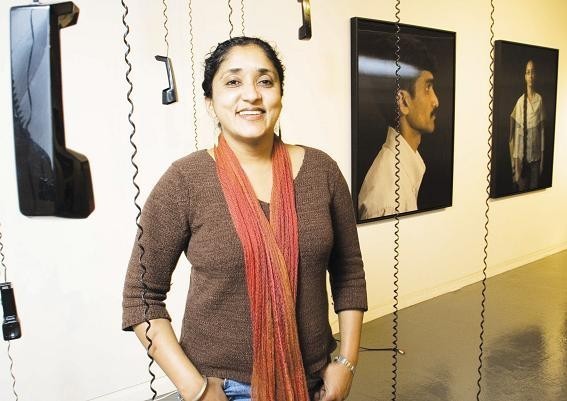
Every day in India, hundreds of thousands of workers answer calls for U.S. companies, mimicking American accents and adopting names such as Paul, Arnold, Sara and Lisa.
But a funny thing is starting to happen, says Annu Palakunnathu Matthew. Indian call-center employees are also bringing aspects of Western culture into their non-professional lives.
Matthew noticed it a few years ago, when she returned to India for her annual visit with friends and family. She met a young man who was “more American than I am” – yet he’d never set foot in the United States, while she’d been living here at least 10 years.
The experience so struck Matthew that, when she returned to Rhode Island, she applied for grants to fund a one-year study of the call-center workers, and she took a sabbatical from her job as assistant professor of art at the University of Rhode Island.
The result of her work is an audio-visual exhibition on display through Dec. 10 at the main gallery in URI’s Fine Arts Center in Kingston. The exhibit explores the potentially homogenizing nature of globalization through the experiences of about 10 call-center workers.
Matthew’s photographs show the workers dressed in Western attire from one angle and traditional Indian attire from another angle. Excerpts of recorded interviews play continuously in the background. She calls the exhibit “The Virtual Immigrant.”
Digital technology has made it possible to outsource call-center jobs to India, but has also created a new kind of Indian-American identity, she said.
Call-center employees receive training on baseball and other Western pastimes, to help them relate to American callers, she said. They watch television shows such as “Friends,” to help them mimic American accents.
One woman told her she’s started eating with a knife and fork, instead of with her hands, as is traditional in India, Matthew said. And for many, the experience of working in a call center is changing their perspectives on the caste system and arranged marriages.
“Most of those who work in the call centers are young,” in their late 20s to 30s, Matthew said.
At work, they see people treated equally, regardless of caste, religion and social background, she said, and they question why all of India can’t be like that.
“When you come out of the office, you think that the whole world is equal,” said Rekha, a call-center employee whom Matthew interviewed. “There is nobody in a higher position or lower … so you talk to everybody in the same manner.”
And as a result, there are more love marriages – as opposed to arranged marriages – taking place among call center employees, Matthew said.
But the call-center culture has negative impacts, in addition to positive ones.
“Some of them are blindly following aspects of Westernization in their personal behavior,” Matthew said. “They think everyone in America parties all weekend, so [they] drink on the weekend.” It is becoming the “in” thing or “cool” thing to do, she said.
Rashmi, a call-center employee interviewed by Matthew, noted that many Indian girls have started smoking. “It is really bad. Why give up our Indian tradition?” He added: “Let us remain as Indians. Work for them, that’s OK … but why transform yourself to Western? I don’t believe in that.”
Another aspect of the workers’ Westernization can be seen in a new materialism, Matthew said. Call-center employees earn about $400 to $500 per month, which is comparable to earning $3,000 to $5,000 per month in the United States.
“Some are earning more money than their parents,” Matthew said. “They are becoming even more materialistic, wanting certain brands” – American brands.
India is a growing market for U.S. companies, which is why the John H. Chafee Center for International Business at Bryant University has been encouraging local businesses to develop relationships in India, said Dennis McCarthy, global link manager at the center.
In April, eight local companies – from manufacturers to software developers – visited India on a trade mission co-sponsored by the center and the R.I. Economic Development Corporation. And the business center is organizing a large trade conference during the next six to eight months for Rhode Island businesses wanting to do business with India, said Hirak Biswas, executive consultant for the center’s India business program.
“India has 300 million people that can afford what we can afford here,” as a middle class, Biswas said. “Young people working for Western companies are creating wealth, increasing the level of disposable income.”
Many factors make doing business with India easy for American companies, Bis-was said including the country’s stable banking system, democratic government and large English-speaking population, all of which make it more desirable than countries such as China.
In addition, the homogenization of the work force is creating Indian employees who even think like Westerners, Matthew said.
“During my nine hours of shift, I speak to an American, and then I even think like an American,” said Vinay, a call-center employee interviewed for the exhibit. “If he is hit by a hurricane, I feel that even I am hit by a hurricane.”
Matthew added: “I don’t know how it will affect India as a whole … but for many, they consider themselves as different. They do think [working for a U.S. company has] changed them.”










